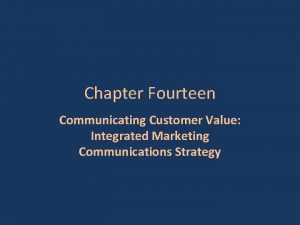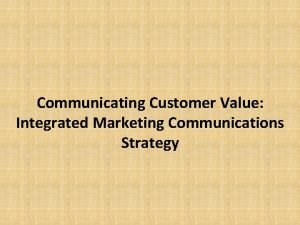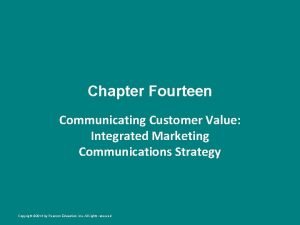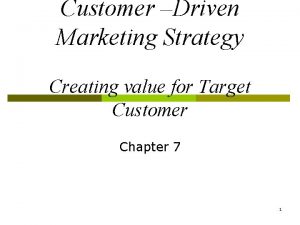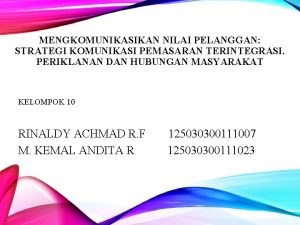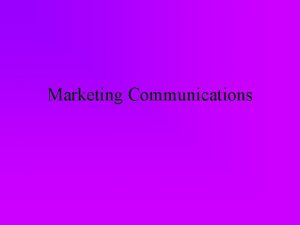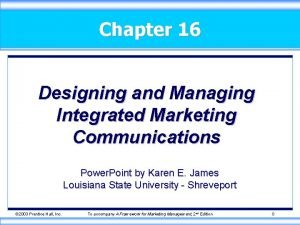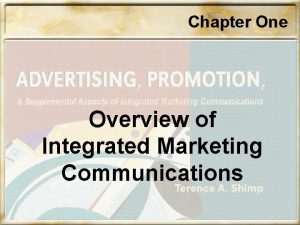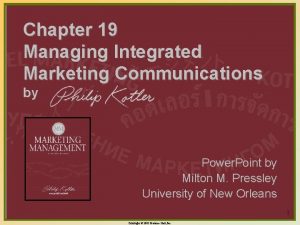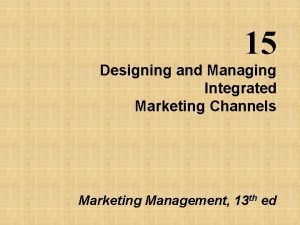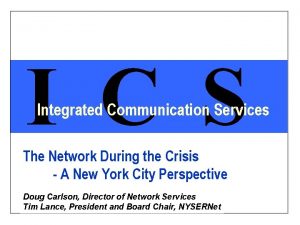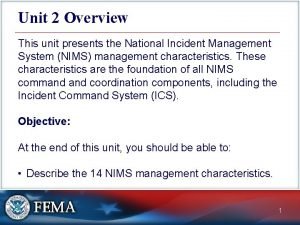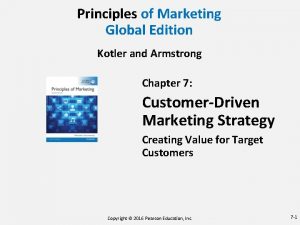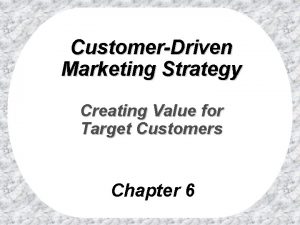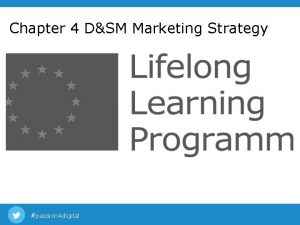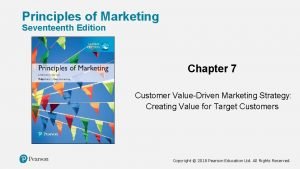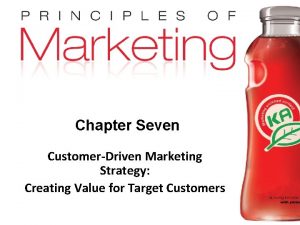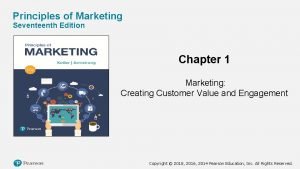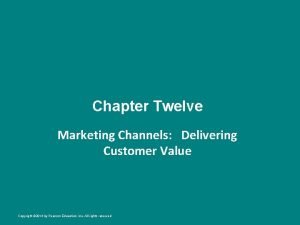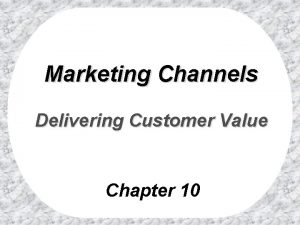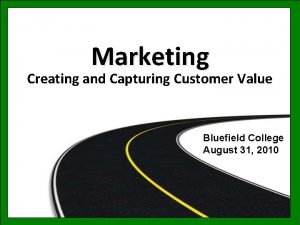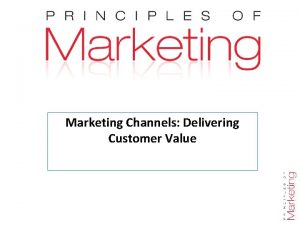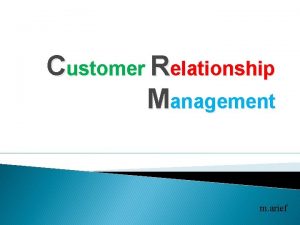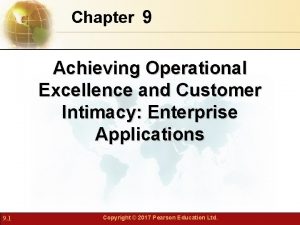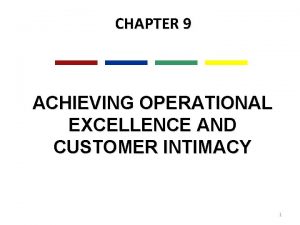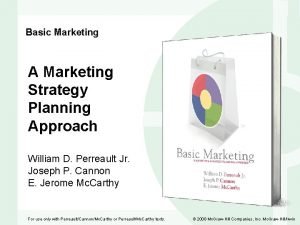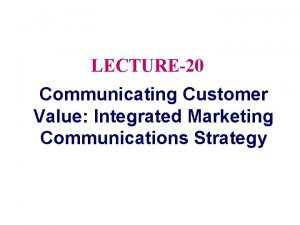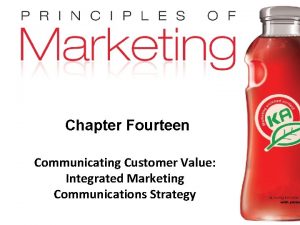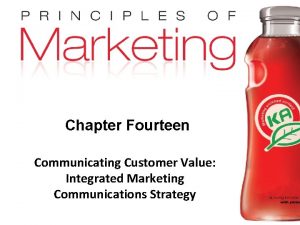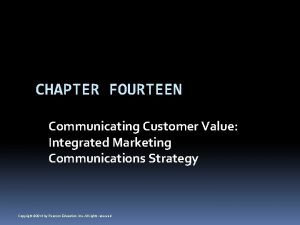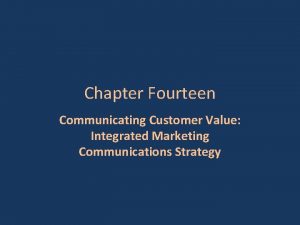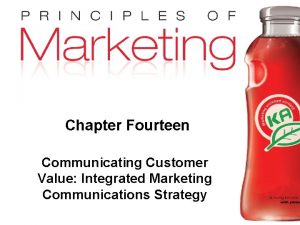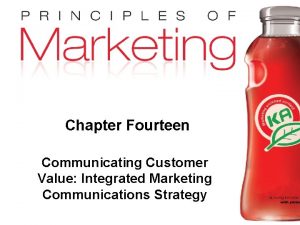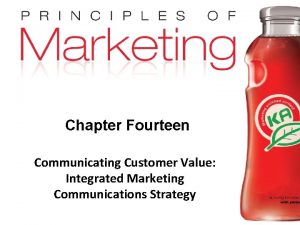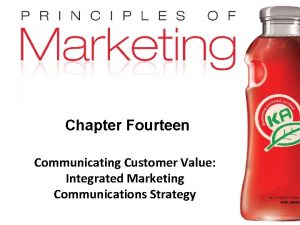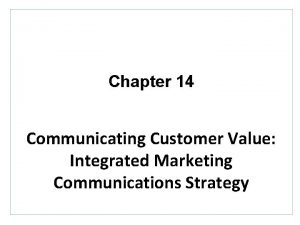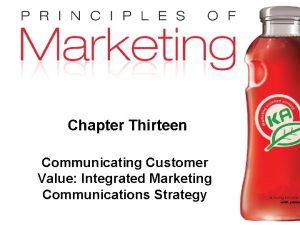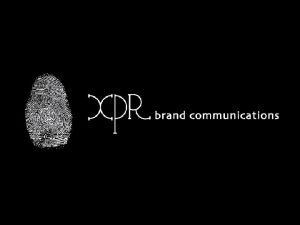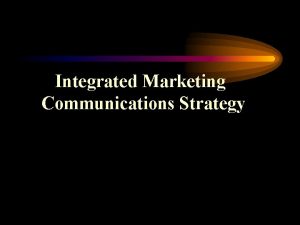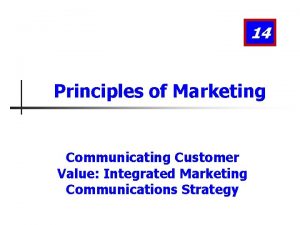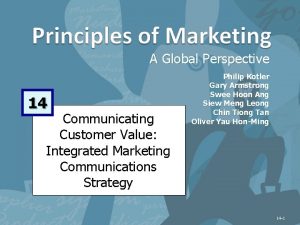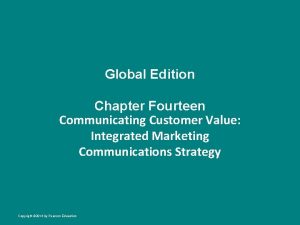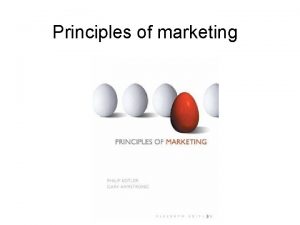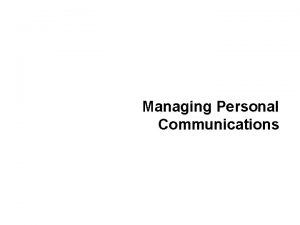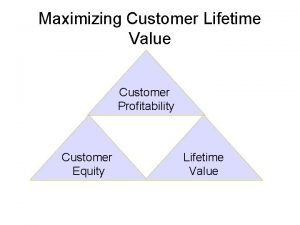Marketing Communicating Customer Value Integrated Marketing Communications Strategy







































- Slides: 39

Marketing Communicating Customer Value Integrated Marketing Communications Strategy

1 -The Promotion Mix �A company’s total Promotion Mix—also called its Marketing Communications Mix—consists of the specific blend of the five major promotion tools are defined as follows: � • Advertising: Any paid form of non-personal presentation and promotion of ideas, goods, or services by an identified sponsor. � • Sales Promotion: Short-term incentives to encourage the purchase or sale of a product or service. � • Personal Selling: Personal presentation by the firm’s sales force for the purpose of making sales and building customer relationships. � • Public Relations: Building good relations with the company’s various publics by obtaining favorable publicity, building up a good corporate image, and handling or heading off unfavorable rumors, stories, and events. � • Direct Marketing: Direct connections with carefully targeted individual consumers to both obtain an immediate response and cultivate lasting customer relationships.

1 -The Promotion Mix �Each category involves specific promotional tools used to communicate with customers. �Advertising: includes broadcast, print, Internet, outdoor, and other forms. � Sales Promotion: includes discounts, coupons, displays, and demonstrations. �Personal Selling: includes sales presentations, trade shows, and incentive programs. �Public Relations (PR): includes press releases, sponsorships, special events, and Web pages. �Direct Marketing: includes catalogs, telephone marketing, kiosks, the Internet, mobile marketing, and more.

1 -The Promotion Mix �At the same time, marketing communication goes beyond these specific promotion tools. �The products design, its price, the shape and color of its package, and the stores that sell it all communicate something to buyers. �Thus, although the Promotion Mix is the company’s primary communications activity, the entire marketing mix— promotion and product, price, and place—must be coordinated for greatest impact.

2 -Integrated Marketing Communications �In past decades, marketers perfected the art of Mass Marketing: selling highly standardized products to masses of customers. § In the process, they developed effective mass-media communications techniques to support these strategies. § Large companies now routinely invest millions or even billions of dollars in television, magazine, or other massmedia advertising, reaching tens of millions of customers with a single ad. �Today, however, marketing managers face some new marketing communications realities. �Perhaps no other area of marketing is changing so profoundly as marketing communications, creating both exciting and anxious times for marketing communicators.

2 -Integrated Marketing Communications ØThe New Marketing Communications Model �Several major factors are changing the face of today’s marketing communications. v First, Consumers are changing. �In this digital, wireless age, they are better informed and more communications empowered. �Rather than relying on marketer-supplied information, they can use the Internet and other technologies to find information on their own, exchange brand-related information or even create their own marketing messages. v Second, Marketing Strategies are changing. � As mass markets have fragmented, marketers are shifting away from mass marketing. �More and more, they are developing focused marketing programs designed to build closer relationships with customers in more narrowly defined micro markets.

2 -Integrated Marketing Communications The New Marketing Communications Model v Finally, advances in Communications Technology: �Sweeping advances in communications technology are causing remarkable changes in the ways in which companies and customers communicate with each other. �The digital age has spawned a host of new information and communication tools—from smartphones and i. Pods to satellite and cable television systems to the many faces of the Internet (e-mail, social networks, blogs, brand Web sites, and so much more). �As mass marketing once gave rise to a new generation of mass -media communications, the new digital media have given birth to a new marketing communications model. § Although television, magazines, newspapers, and other mass media remain very important, their dominance is declining. § Advertisers are now adding a broad selection of more-specialized and highly targeted media to reach smaller customer segments with more-personalized, interactive messages.

2 -Integrated Marketing Communications The New Marketing Communications Model �The new media range from specialty cable television channels and made-for-the-Web videos to Internet catalogs, e-mail, blogs, cell phone content, and online social networks. �In all, companies are doing less broadcasting and more narrowcasting. § Mass media costs are rising, audiences are shrinking, ad clutter is increasing, and viewers are gaining control of message exposure through technologies, that let them skip past disruptive television commercials. �As a result, they suggest, marketers are shifting ever-larger portions of their marketing budgets away from old-media mainstays such as 30 second TV commercials and glossy magazine ads to digital and other new-age media. § Despite the shift toward new digital media, however, traditional mass media still capture a lion’s share of the promotion budgets of most major marketing firms, a fact that probably won’t change quickly. �Regardless of whether it’s traditional or digital, the key is to find the mix of media that best communicates the brand message and enhances the customer’s brand experience.

2 -Integrated Marketing Communications ØThe Need for Integrated Marketing Communications �The shift toward a richer mix of media and communication approaches poses a problem for marketers. § Consumers today are bombarded by commercial messages from a broad range of sources, but consumers don’t distinguish between message sources the way marketers do. § Conflicting messages from these different sources can result in confused company images, brand positions, and customer relationships. �All too often, companies fail to integrate their various communications channels, the result is a hodgepodge of communications to consumers. § In-store promotion sends a different signal, and company sales literature creates still another message. And the company’s web site, e-mails, Facebook page, or videos posted on You. Tube say something altogether different. �The problem is that these communications often come from different parts of the company.

2 -Integrated Marketing Communications The Need for Integrated Marketing Communications �Advertising messages are planned and implemented by the advertising department or an ad agency. �Personal selling communications are developed by sales management. § Other company specialists are responsible for PR, sales promotion events, Internet or social network efforts, and other forms of marketing communications. �However, whereas these companies have separated their communications tools, customers don’t, mixed communications from these sources result in blurred brand perceptions by consumers. �Today, more companies are adopting the concept of Integrated Marketing Communications (IMC), under this concept, as illustrated in Figure 14. 1, the company carefully integrates its many communications channels to deliver a clear, consistent, and compelling message about the organization and its brands.


2 -Integrated Marketing Communications The Need for Integrated Marketing Communications �Integrated marketing communications calls for recognizing all touchpoints where the customer may encounter the company and its brands. �Each brand contact will deliver a message—whether good, bad, or indifferent. �The company’s goal should be to deliver a consistent and positive message to each contact. �IMC leads to a total marketing communications strategy aimed at building strong customer relationships by showing how the company and its products can help customers solve their problems. �Integrated marketing communications ties together all of the company’s messages and images. § Its television and print ads have the same message, look, and feel as its e-mail and personal selling communications, and its PR materials project the same image as its Web site or social network presence.

2 -Integrated Marketing Communications The Need for Integrated Marketing Communications �Often, different media play unique roles in attracting, informing, and persuading consumers; these roles must be carefully coordinated under the overall marketing communications plan. �In the past, no one person or department was responsible for thinking through the communication roles of the various promotion tools and coordinating the promotion mix. �To help implement integrated marketing communications, some companies have appointed a marketing Communications Director who has overall responsibility for the company’s communications efforts. �This helps to produce better communications consistency and greater sales impact. �It places the responsibility in someone’s hands—where none existed before—to unify the company’s image as it is shaped by

3 -A View of the Communication Process �Integrated marketing communications involves identifying the target audience and shaping a well-coordinated promotional program to obtain the desired audience response. �Today, marketers are moving toward viewing communications as managing the customer relationship over time. �Because customers differ, communications programs need to be developed for specific segments, niches, and even individuals. � And, given the new interactive communications technologies, companies must ask not only: § “How can we reach our customers? ” § but also “How can we let our customers reach us? ”

3 -A View of the Communication Process �The communications process should start with an audit of all the potential touchpoints that target customers may have with the company and its brands. § For example, someone purchasing a new cell phone plan may talk to others, see television ads, read articles and ads in newspapers and magazines, and visit various Web sites for prices and reviews, and check out plans at Best Buy, Walmart, or a wireless provider’s kiosk or store at the mall. �The marketer needs to assess what influence each communication experience will have at different stages of the buying process. § This understanding helps marketers allocate their communication dollars more efficiently and effectively. �To communicate effectively, marketers need to understand how communication works.

3 -A View of the Communication Process �Communication involves the Nine elements shown in Figure 14. 2. ü Two of these elements are the major parties in a communication—the sender and the receiver. ü Another two are the major communication tools—the message and the media. ü Four more are major communication functions—encoding, decoding, response, and feedback. ü The last element is noise in the system.


3 -A View of the Communication Process �Definitions of these elements follow and are applied to a Mc. Donald’s “i’m lovin’ it” television commercial. � • Sender: The party sending the message to another party— here, Mc. Donald’s. � • Encoding: The process of putting thought into symbolic form—for example, Mc. Donald’s ad agency assembles words, sounds, and illustrations into a TV advertisement that will convey the intended message. � • Message: The set of symbols that the sender transmits— the actual Mc. Donald’s ad. � • Media: The communication channels through which the message moves from the sender to the receiver—in this case, television and the specific television programs that Mc. Donald’s selects.

3 -A View of the Communication Process � • Decoding: The process by which the receiver assigns meaning to the symbols encoded by the sender—a consumer watches the Mc. Donald’s commercial and interprets the words and images it contains. � • Receiver: The party receiving the message sent by another party—the Customer who watches the Mc. Donald’s ad. � • Response: The reactions of the receiver after being exposed to the message—any of hundreds of possible responses, such as the consumer likes Mc. Donald’s better, is more likely to eat at Mc. Donald’s next time, hums the “i’m lovin’ it” jingle, or does nothing.

3 -A View of the Communication Process � • Feedback: The part of the receiver’s response communicated back to the sender—Mc. Donald’s research shows that consumers are either struck by and remember the ad or they write or call Mc. Donald’s, praising or criticizing the ad or its products. � • Noise: The unplanned static or distortion during the communication process, which results in the receiver getting a different message than the one the sender sent—the consumer is distracted while watching the commercial and misses its key points. �For a message to be effective, the sender’s encoding process must mesh with the receiver’s decoding process. �The best messages consist of words and other symbols that are familiar to the receiver.

9/17/2021 21

3 -A View of the Communication Process �The more the sender’s field of experience overlaps with that of the receiver, the more effective the message is likely to be. �Marketing communicators may not always share their customer’s field of experience. �For example, an advertising copywriter from one socioeconomic level might create ads for customers from another level—say, wealthy business owners. �However, to communicate effectively, the marketing communicator must understand the customer’s field of experience. �Senders need to know what audiences, must be good at encoding messages, must send messages through media that reach target audiences, and develop feedback channels so that they can assess an audience’s response to the message.

4 -Steps in Developing Effective Marketing Communication �The steps in developing an effective integrated communications and promotion program, marketers must do the following: Ø Identifying the Target Audience Ø Determining the Communication Objectives Ø Designing a Message ü ü ü Message Content Message Structure Message Format Ø Choosing Media ü Personal Communication Channels ü Non-personal Communication Channels Ø Selecting the Message Source Ø Collecting Feedback

4 -Steps in Developing Effective Marketing Communication ØIdentifying the Target Audience �A marketing communicator starts with a clear target audience in mind. § The audience may be current users or potential buyers, those who make the buying decision or those who influence it. § The audience may be individuals, groups, special publics, or the general public. �The target audience will heavily affect the communicator’s decisions on: ü what will be said, ü how it will be said, ü when it will be said, ü where it will be said, and ü who will say it.

4 -Steps in Developing Effective Marketing Communication ØDetermining the Communication Objectives �They will seek a purchase response, but purchase may result only after a lengthy consumer decision-making process. �The marketing communicator needs to know where the target audience now stands and to what stage it needs to be moved. � The target audience may be in any of six buyer-readiness stages, include awareness, knowledge, liking, preference, conviction, and purchase (figure 14. 3). �The marketing communicator’s target market may be totally unaware of the product, know only its name, or know only a few things about it. �Thus, the communicator must first build awareness and knowledge. �Assuming that target consumers know about the product, how do they feel about it?


4 -Steps in Developing Effective Marketing Communication Determining the Communication Objectives § Once potential buyers knew about the redesigned Sorento, Kia’s marketers wanted to move them through successively stronger stages of feelings toward the new model. �These stages include liking (feeling favorable about the CUV), preference (preferring the Sorento to other CUVs), and conviction (believing that the Sorento is the best vehicle for them). § Kia marketers used a combination of the promotion mix tools to create positive feelings and conviction. �The initial commercials helped build anticipation and an emotional brand connection. �Finally, some members of the target market might be convinced about the product but not quite get around to making the purchase. �Potential Sorento buyers might have decided to wait for more information or for the economy to improve.

4 -Steps in Developing Effective Marketing Communication Determining the Communication Objectives �The communicator must lead these consumers to take the final step. �Actions might include offering special promotional prices, rebates, or premiums. �Dealers might call, write, or e-mail selected customers, inviting them to visit the showroom. § The Sorento Web site even offers a $25 gift card for simply signing up for a test drive at a local Kia dealership. �The more quickly potential buyers learn about the poor product, the more quickly they become aware of its faults. �Thus, good marketing communications call for “good deeds followed by good words. ”

4 -Steps in Developing Effective Marketing Communication ØDesigning a Message �Having defined the desired audience response, the communicator then turns to developing an effective message. � Ideally, the message should: ü Get attention, ü Hold interest, ü Arouse desire, and ü Obtain action (a framework known as the AIDA model). �In practice, few messages take the consumer all the way from awareness to purchase, but the AIDA framework suggests the desirable qualities of a good message. �When putting the message together, the marketing communicator must decide what to say (message content) and how to say it (message structure and format).

4 -Steps in Developing Effective Marketing Communication Designing a Message ØMessage Content �There are three types of appeals: �Rational Appeals: relate to the audience’s self-interest, they show that the product will produce the desired benefits. § Examples are messages showing a product’s quality, economy, value, or performance. �Emotional Appeals: attempt to stir up either negative or positive emotions that can motivate purchase. § Communicators may use emotional appeals ranging from love, joy, and humor to fear and guilt, they attract more attention and create more belief in the sponsor and the brand. �Moral Appeals: are directed to an audience’s sense of what is “right” and “proper, ” they are often used to urge people to support social causes, such as a cleaner environment or aid to the disadvantaged. § For example, the United Way’s Live United campaign urges people to give back to their communities—to “Live United. Make a difference.

4 -Steps in Developing Effective Marketing Communication ØMessage Structure �The first is whether to draw a conclusion or leave it to the audience. § Research suggests that, in many cases, rather than drawing a conclusion, the advertiser is better off asking questions and letting buyers come to their own conclusions. �The second message structure issue is whether to present the strongest arguments first or last. § Presenting them first gets strong attention but may lead to an anticlimactic ending. �The third message structure issue is whether to present a onesided argument (mentioning only the product’s strengths) or a twosided argument (touting the product’s strengths while also admitting its shortcomings). § Usually, a one-sided argument is more effective in sales presentations— except when audiences are highly educated or likely to hear opposing claims or when the communicator has a negative association to overcome. § In such cases, two-sided messages can enhance an advertiser’s credibility and make buyers more resistant to competitor attacks.

4 -Steps in Developing Effective Marketing Communication ØMessage Format �The marketing communicator also needs a strong format for the message. § To attract attention, advertisers can use novelty and contrast; eye- catching pictures and headlines; distinctive formats; message size and position; and color, shape, and movement. �If the message is to be carried over the radio, the communicator has to choose words, sounds, and voices. § The “sound” of an ad promoting banking services should be different from one promoting an i. Pod. �If the message is to be carried on television or in person, then all these elements plus body language must be planned. § Presenters plan every detail—facial expressions, gestures, dress, posture, and hairstyles. �If the message is carried on the product or its package, the communicator must watch texture, scent, color, size, and shape. § For example, color alone can enhance message recognition for a brand, think about Target (red), Mc. Donald’s (yellow and red), IBM (blue).

4 -Steps in Developing Effective Marketing Communication ØChoosing Media �The communicator must now select the: v Personal Communication Channels �In personal communication channels, two or more people communicate directly with each other. �They might communicate face to face, on the phone, via mail or e- mail, or even through an Internet “chat. ” �Personal communication channels are effective because they allow for personal addressing and feedback. �Some personal communication channels are controlled directly by the company. § § For example, company salespeople contact business buyers, but other personal communications about the product may reach buyers through channels not directly controlled by the company. These channels might include independent experts—consumer advocates, online buying guides, and others making statements to buyers.

4 -Steps in Developing Effective Marketing Communication Choosing Media Personal Communication Channels �This last channel, word-of-mouth influence, has considerable effect in many product areas. �Personal influence carries great weight for products that are expensive, risky, or highly visible. § Consider the power of simple customer reviews on Amazon. com: It doesn’t matter how loud or often you tell consumers your “truth, ” few today are buying a big-ticket item before they know what existing users have to say about the product. �This is a low-trust world, that’s why “recommendation by a relative or friend” comes out on top in just about every survey of purchasing influences. § Customer reviews are also a major reason for Amazon’s success in growing sales per customer.

4 -Steps in Developing Effective Marketing Communication Choosing Media Personal Communication Channels �Can create opinion leaders for their brands— people whose opinions are sought by others—by supplying influencers with the product on attractive terms or by educating them so that they can inform others. � Buzz marketing involves cultivating opinion leaders and getting them to spread information about a product or service to others in their communities. § P&G has created a huge word-of-mouth marketing arm— Vocalpoint— consisting of 500, 000 moms. �It simply educated the Vocalpointers about the product, armed them with free samples and coupons for friends, and then asked them to share their “honest opinions with us and with other real women. ” �In turn, the Vocalpoint moms created hundreds of thousands of personal recommendations for the new product.

4 -Steps in Developing Effective Marketing Communication Choosing Media v. Non-personal Communication Channels �Non-personal communication channels are media that carry messages without personal contact or feedback. § They include major media, atmospheres, and events. § Major media include print media (newspapers, magazines, direct- mail), broadcast media (television, radio), display media (billboards, signs, posters), and online media (e-mail, company Web sites, and online social and sharing networks). �Atmospheres are designed environments that create or reinforce the buyer’s leanings toward buying a product. § Thus, lawyers’ offices and banks are designed to communicate confidence and other qualities that might be valued by clients. �Events are staged occurrences that communicate messages to target audiences. § For example, PR departments arrange grand openings, shows and exhibits, public tours, and other events.

4 -Steps in Developing Effective Marketing Communication Choosing Media Non-personal Communication Channels �Non-personal communication affects buyers directly. �In addition, using mass media often affects buyers indirectly by causing more personal communication. § For example, communications might first flow from television, magazines, and other mass media to opinion leaders and then from these opinion leaders to others. �Thus, opinion leaders step between the mass media and their audiences and carry messages to people who are less exposed to media. �Interestingly, marketers often use non-personal communications channels to replace or stimulate personal communications by embedding consumer endorsements or word-of-mouth testimonials in their ads and other promotions.

4 -Steps in Developing Effective Marketing Communication Choosing Media ØSelecting the Message Source �In either personal or non-personal communication, the message’s impact also depends on how the target audience views the communicator. �Messages delivered by highly credible sources are more persuasive. § Thus, many food companies promote to doctors, dentists, and other health-care providers to motivate these professionals to recommend specific food products to their patients. § And marketers hire celebrity endorsers—well-known athletes, actors, musicians, and even cartoon characters—to deliver their messages. �“Arranged marriages between brands and celebrities are inherently risky, ” notes one expert. �“Ninety-nine percent of celebrities do a strong job for their brand partners, ” says another, “and 1 percent goes off the rails. ”

4 -Steps in Developing Effective Marketing Communication Choosing Media ØCollecting Feedback �After sending the message, the communicator must research its effect on the target audience. § This involves asking the target audience members whether they remember the message, how many times they saw it, what points they recall, how they felt about the message, and their past and present attitudes toward the product and company. �The communicator would also like to measure behavior resulting from the message—how many people bought the product, talked to others about it, or visited the store. �Feedback on marketing communications may suggest changes in the promotion program or in the product offer itself. § For example, Macy’s uses television and newspaper advertising to inform area consumers about its stores, services, and merchandising events.
 Communicating customer value
Communicating customer value Communicating customer value
Communicating customer value Communicating customer value
Communicating customer value Communicating vs non communicating hydrocele
Communicating vs non communicating hydrocele Customer value driven marketing strategy
Customer value driven marketing strategy Communicating value in marketing management
Communicating value in marketing management Encoding and decoding advertising
Encoding and decoding advertising Alokesh banerjee
Alokesh banerjee Designing and managing integrated marketing communications
Designing and managing integrated marketing communications Imc of coca cola
Imc of coca cola Designing and managing integrated marketing communications
Designing and managing integrated marketing communications Overview of integrated marketing communications
Overview of integrated marketing communications Designing and managing integrated marketing communications
Designing and managing integrated marketing communications Communications mix
Communications mix Designing and managing integrated marketing communications
Designing and managing integrated marketing communications Integrated communications services
Integrated communications services To avoid overburdening the incident command
To avoid overburdening the incident command Contoh value creation adalah
Contoh value creation adalah Kotler and armstrong
Kotler and armstrong Customer driven marketing strategy
Customer driven marketing strategy Key elements of customer driven marketing strategy
Key elements of customer driven marketing strategy Customer acquisition strategy digital marketing
Customer acquisition strategy digital marketing Principles of marketing chapter 7
Principles of marketing chapter 7 Design a customer driven marketing strategy
Design a customer driven marketing strategy How to design a customer driven marketing strategy
How to design a customer driven marketing strategy Value strategy marketing
Value strategy marketing Creating customer value and engagement
Creating customer value and engagement Marketing channels delivering customer value
Marketing channels delivering customer value Marketing channel objectives
Marketing channel objectives Marketing channels delivering customer value
Marketing channels delivering customer value A simple model of the marketing process
A simple model of the marketing process Vertical marketing system
Vertical marketing system Communications strategy in kansas city
Communications strategy in kansas city Analyzing and using marketing information
Analyzing and using marketing information Customer relationship management and customer intimacy
Customer relationship management and customer intimacy Pengertian customer relation
Pengertian customer relation Beyond customer satisfaction
Beyond customer satisfaction Customer relationship management and customer intimacy
Customer relationship management and customer intimacy Intimacy
Intimacy Universal functions of marketing
Universal functions of marketing
